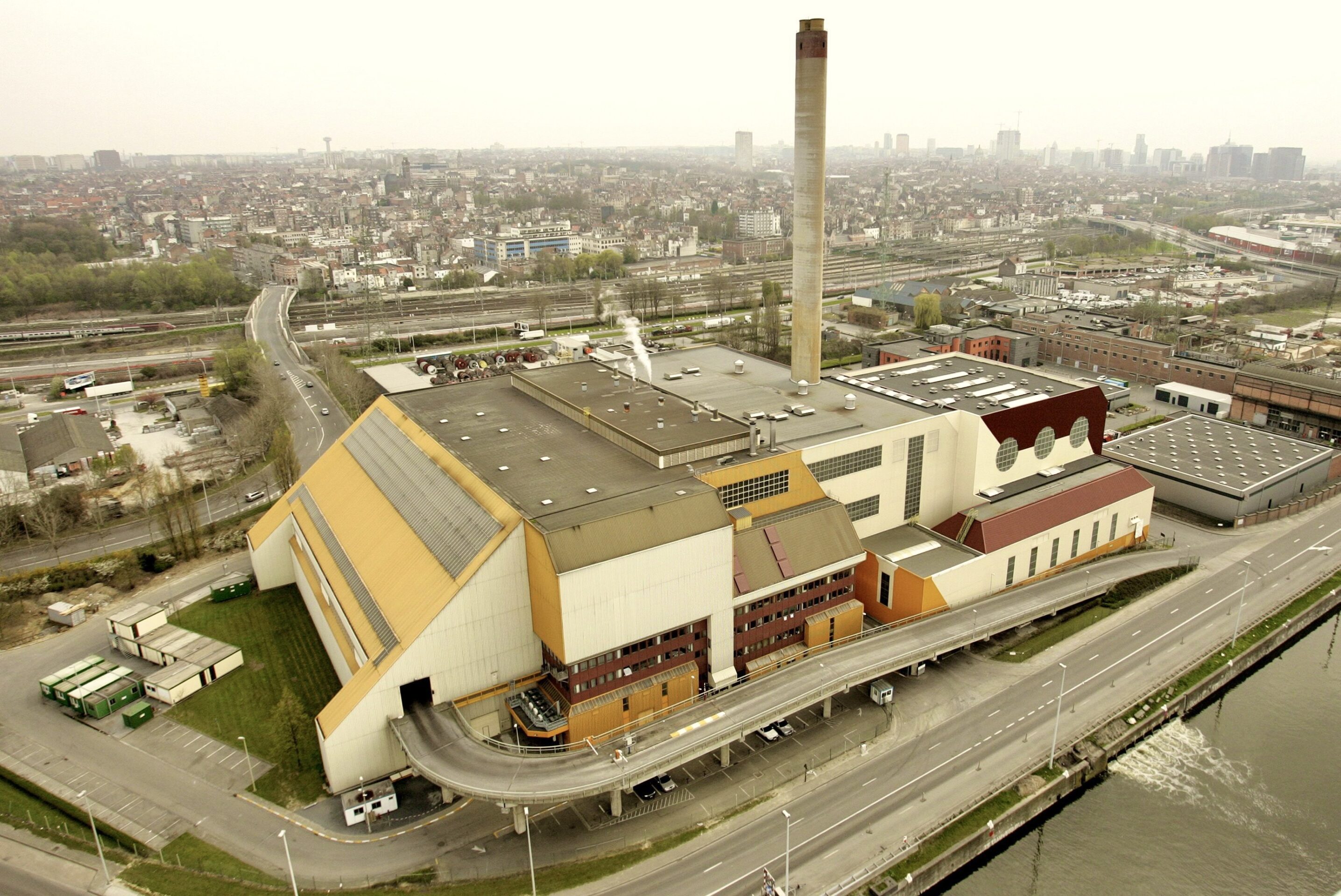Who would have imagined that talking rubbish could be so enlightening?
When the The Brussels Times Magazine editor said he wanted us to take a deep dive into waste, it didn’t sound like the most enticing prospect. But within days, he’s arranged for us to visit the country’s biggest refuse incinerator, a few strokes upstream from the Royal Yacht Club on the Brussels Canal.
The two sites, on opposite banks, seem an unlikely pair. The yacht club, built in 1936 after the original pavilion burned down, is one of the most elegant structures on the waterway. The incinerator with its 106-metre chimney stack, erected on Quai Léon Monnoyer in 1985, is not.
While it might lack the architectural elan of its posh neighbour, the incinerator – much expanded in the 40 years since it started operating – boasts a direct connection with the real regal deal, the Royal Family itself. Heat produced from the plant’s ingenious waste management system is piped to King Philippe’s Laeken Palace and the royal greenhouses. It covers the estate’s entire heating needs, reducing its emissions by 2,000 tonnes a year.
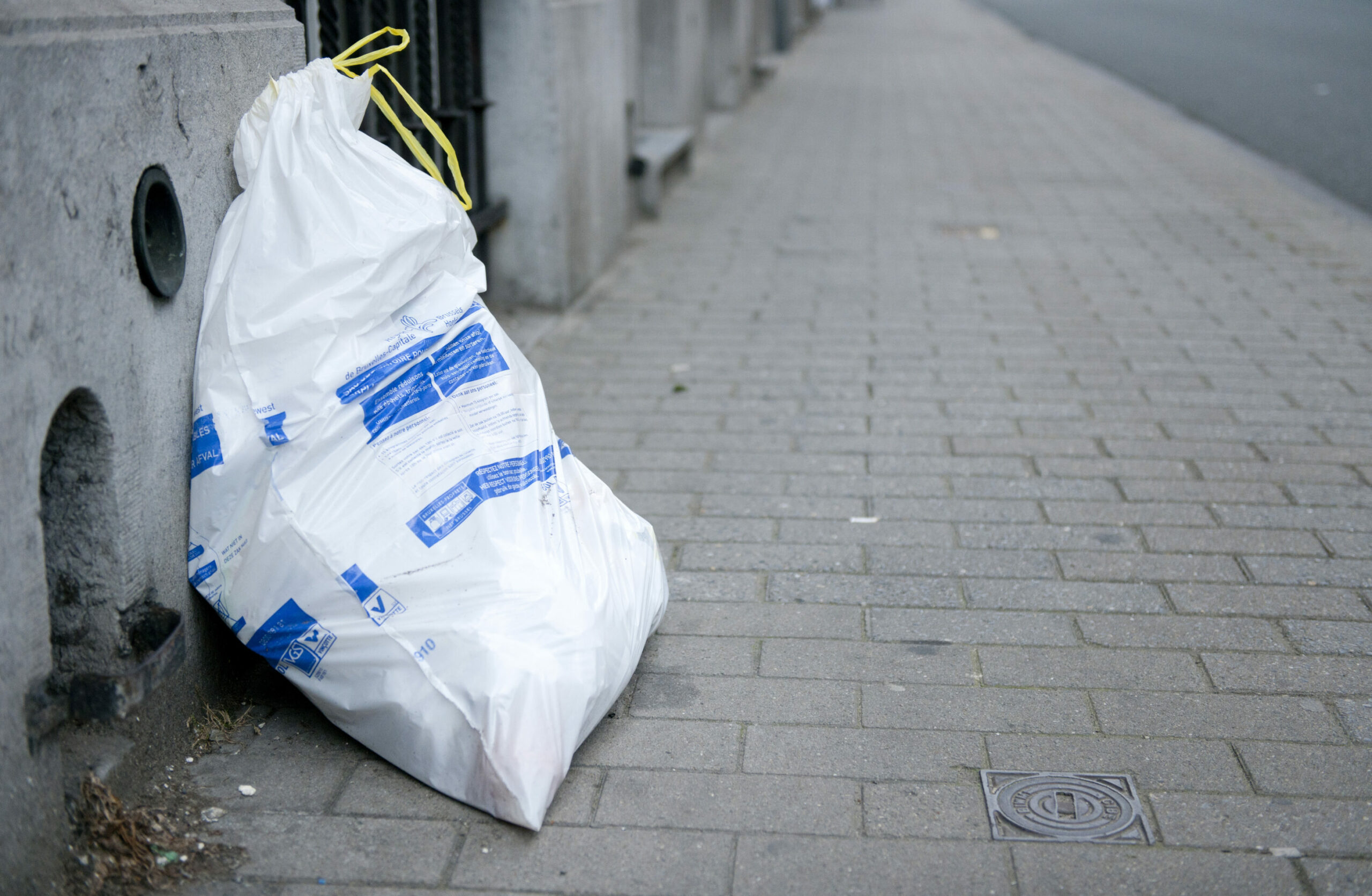
White waste bags. Credit: Belga
The incinerator network also provides heating for the Docks Bruxsel shopping mall and new pipes are being laid to supply nearby schools, public housing and a swimming pool. The plant produces a heck of a lot of steam – nearly three tonnes for every tonne of waste – some of which is used in its turbines to generate electricity for 65,000 households.
And, wait for it, much of this waste-to-energy dividend is down to the thousands of tonnes of white rubbish bags collected from households across Brussels every week (in some areas twice weekly), together with refuse from public bins and containers.
As most readers will know, the white bags are for waste which is not easily recyclable or destined for the other coloured bags, namely: yellow (paper and cardboard), blue (plastics, metal packaging, drink cartons), orange (food or kitchen waste) and green (garden waste).
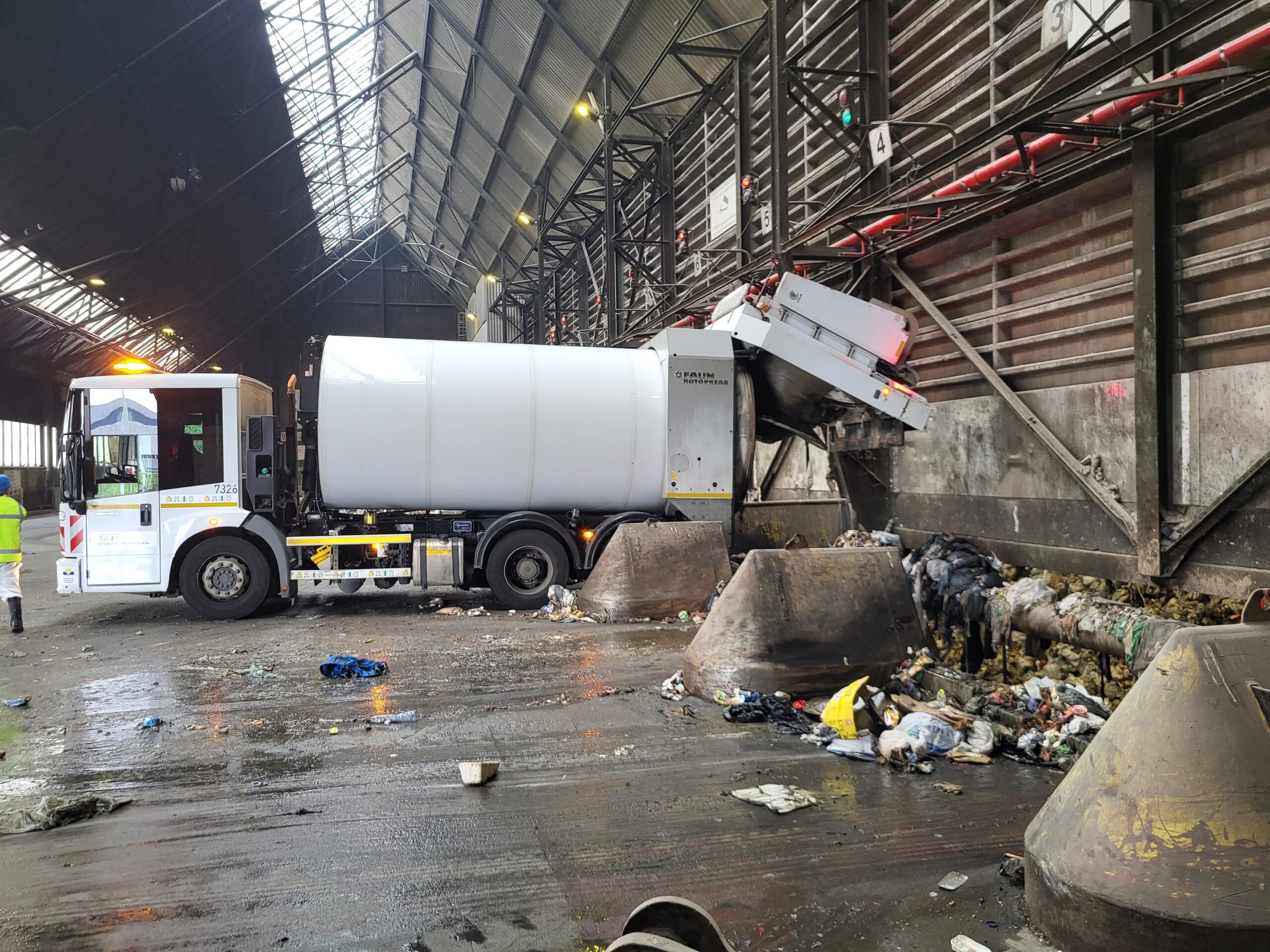
Rubbish lorry unloading into the main pit
The white bags can contain everything from food packaging and bike inner tubes to epic quantities of soiled nappies (diapers). Lovely. Agents from the Brussels region waste authority, Bruxelles-Propreté/Net Brussel, check around 300 bags daily to ensure they contain only authorised waste. Failure to use the right coloured bag can result in fines totalling hundreds of euros if they find evidence to nab you.
Sorting rules
The sorting rules with all the dos and don’ts are explained on the Bruxelles-Propreté website in 12 languages – not only French and Dutch but also English, Spanish, Italian, German, Polish, Turkish, Arabic, Romanian, Portuguese and Bulgarian. So, no excuses, folks.
Rather confusingly, at least for this observer, private operators also deliver residual waste to the incinerator in purple or blue bags, while brown replaces white in some communes bordering Brussels. In the interests of brevity, let’s just say that white bags alone accounted for 170,000 tonnes of the 460,000 tonnes of waste treated at the plant last year.
But back to the visit. We’re welcomed to the complex by Jérémy Hellemans, its youthful-looking CEO and general director for treatment activities. He offers us a warming coffee and shares a box of pastel de nata mini custard tarts he’s picked up en route. Nice one.
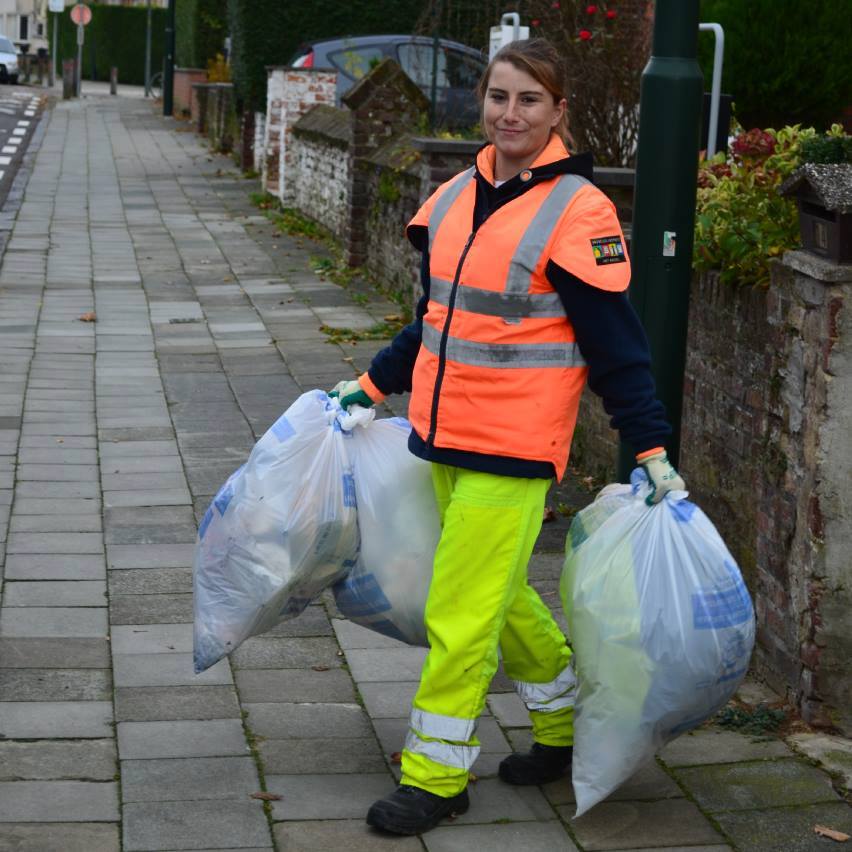
Vanessa, the first bin woman, according to Bruxelles-Proprete
Hellemans jokes that the vast incinerator, with its myriad machinery and industrial processing, is “like Charlie and the Chocolate Factory.” And he wastes no time in detailing the myriad challenges faced by the plant, which range from tough recycling targets and the need for regular revamps, to exploding laughing gas canisters (see separate item), and even, on one occasion, being asked by the cops to locate luggage thought to contain a murder victim’s chopped-up body. It was never found.
The high urban density of Brussels, with its 1.2 million inhabitants, presents particular collection issues. “A lot of people live in old houses that were transformed into apartments where there was no thought about what we are going to do with the waste,” says Hellemans.
Then there are all the different languages and attitudes associated with a multicultural city. “If you take the NATO guy who comes from the US, he doesn't have the same perception of waste as the Scandinavian guy who works for the EU.”
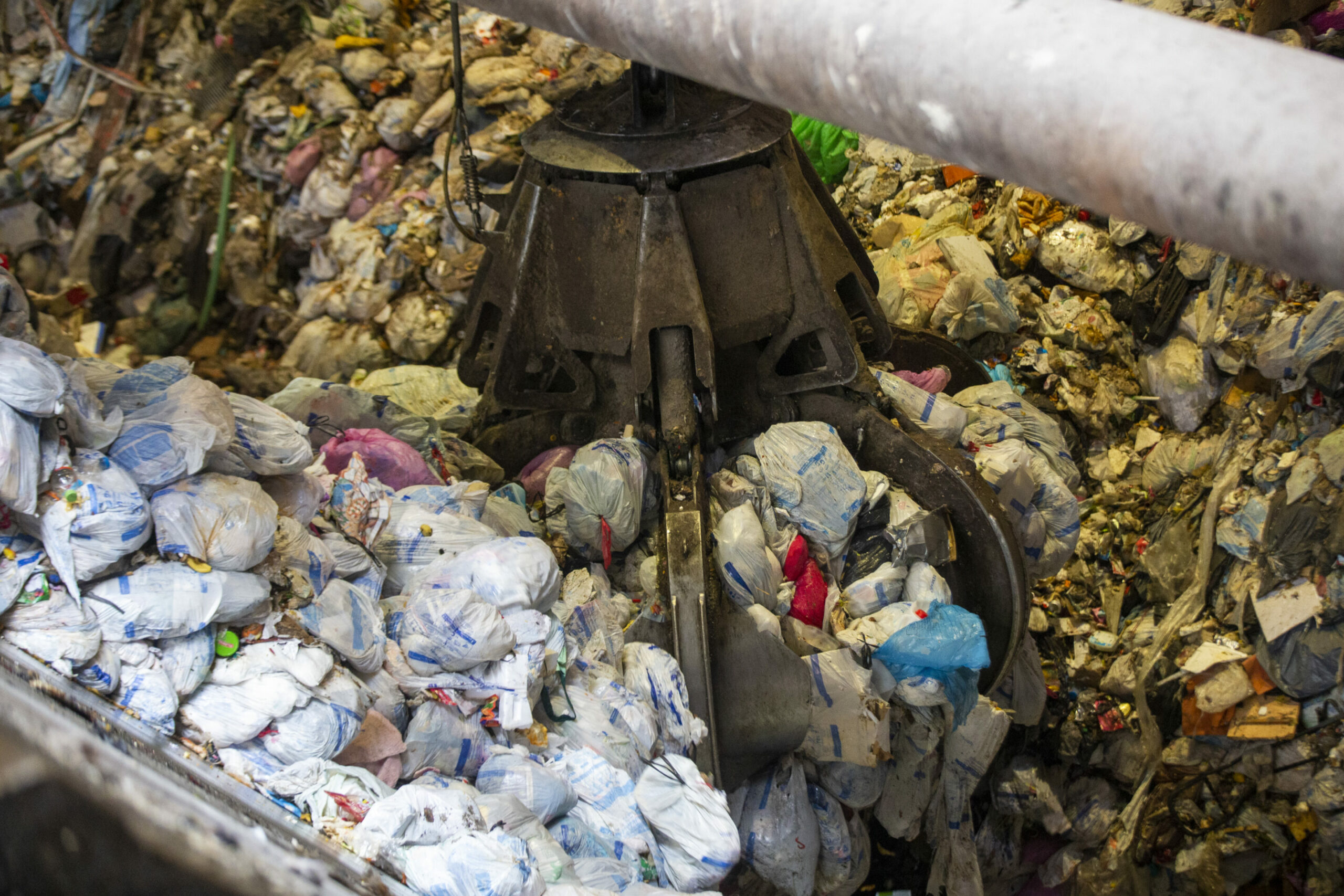
The incinerator of the Brussels Region, Thursday 08 September 2022. Credit: Belga / Nicolas Maeterlinck
If you’ve ever wondered who collects your rubbish, that depends on where you live. “Collections in some streets are carried out by the region, in others it’s the municipality,” says Hellemans. “Household waste is a public service mission, waste produced by businesses is not.”
Businesses, incidentally, need to make contractual arrangements for waste collection. Some, our host concedes, try to get around this by snaffling white bags meant for residents and surreptitiously dumping them away from their premises. If caught, they face heavy fines.
Recycling target
Like all member states, Belgium is bound by EU legislation. Under the EU Waste Framework Directive, re-use and recycling rates for municipal waste should rise to 65% by 2035. “Today we are around 30% of recycled waste so it’s a pretty huge gap to be filled,” Hellemans admits.
Nevertheless, according to the European Environment Agency, Belgium is one of the leaders in the EU when it comes to using waste as a resource and achieving a circular economy. Brussels Capital Region brought in separate collection of food waste in 2013, ten years ahead of deadline, and this year sees the introduction of a separate collection of textiles. “Our goal is to reduce the amount of white bags and to increase the waste put in the other bags and collected via the Recyparks,” Hellemans says.
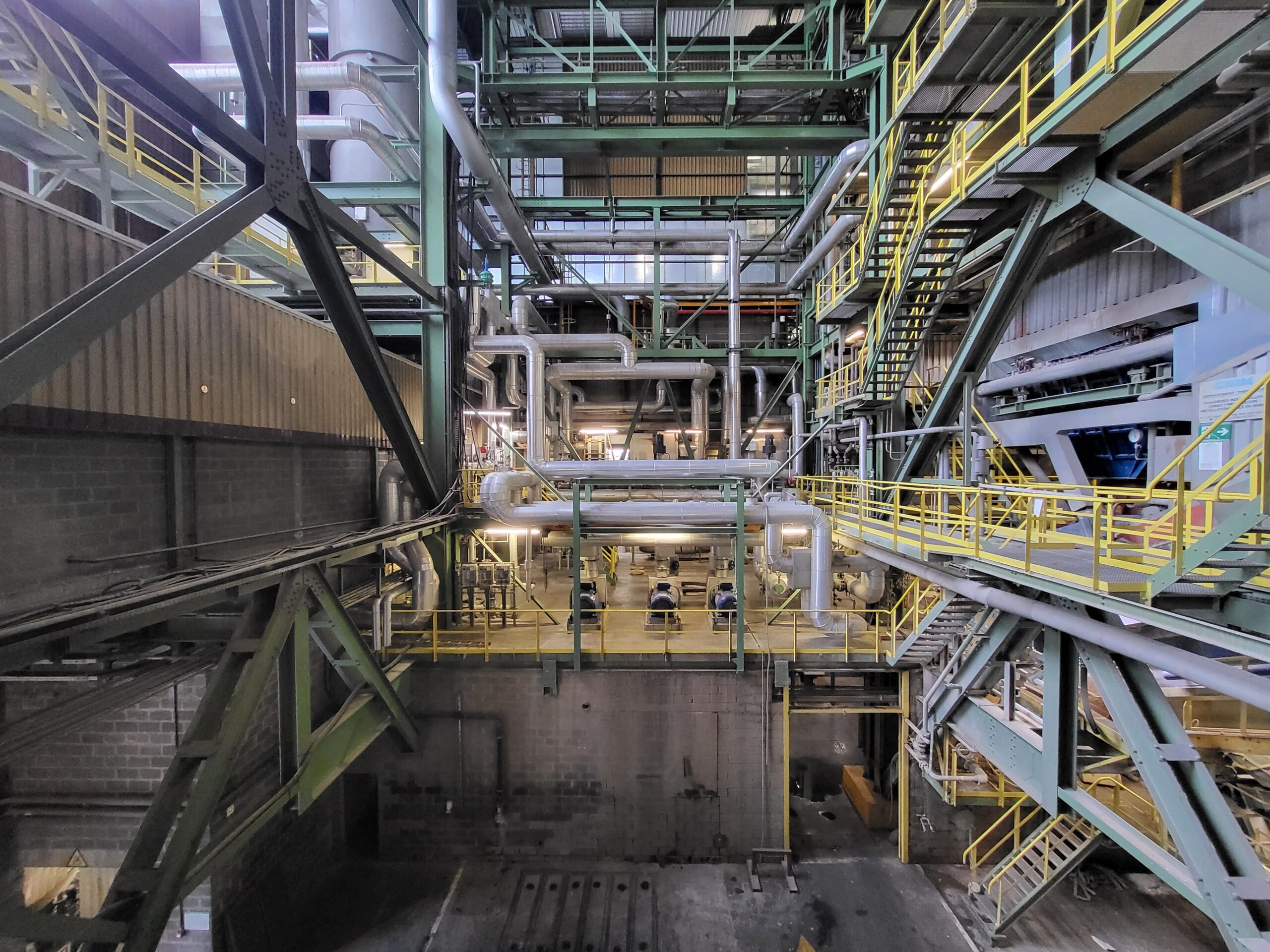
Complex piping inside the incinerator
The capital has six such Recyparks, where residents can dispose of bulky items such as electrical appliances, furniture and mattresses. Buda, situated near the incinerator on Chaussée de Vilvoorde and opened last March, is the largest, covering 31,000 square metres. The others are in Anderlecht (Demets), Forest (Humanité and Sud), Auderghem and Woluwe-Saint-Pierre. Bruxelles-Propreté also operates a mobile recypark which rotates between 14 of the city’s 19 municipalities.
More recycling collection points are on Hellemans’ wishlist but he admits the idea is rarely popular. “When you talk about this, people will say, ‘We need one, but not in my street’. We have to deal with this nimby [not in my back yard] effect and communicate to the maximum with citizens that these are essential for Brussels.”
Hellemans would also like to see Bruxelles-Propreté and its associated arms, Bruxelles-Energie, which runs the incinerator, and Bruxelles-Compost, making better use of the canal, especially for transporting waste, although he admits it costs less for now to carry it on trucks.
The incinerator uses water from the canal for cooling and extracting ash during the waste treatment process, but Hellemans argues the whole ‘value chain’ should tap into the resource. “We’re working on this with the Port de Bruxelles to improve access,” he adds.
Grand tour
So what happens to all those white bags once they are collected and arrive at the plant?
It’s time for our grand tour, accompanied by Hellemans, plant safety manager Patrick Vingerhoets and Bruxelles-Propreté spokesperson Adel Lassouli.
Donned in hard hats, safety glasses and high-vis vests, we make our way to the top of an access ramp, which rises around 20 metres from the road below. On arrival, the bin lorries queue to be weighed – and tested for radioactive substances. Gulp. No-one mentions what happens if the alarm goes off but one hopes it’s a very rare occurrence.
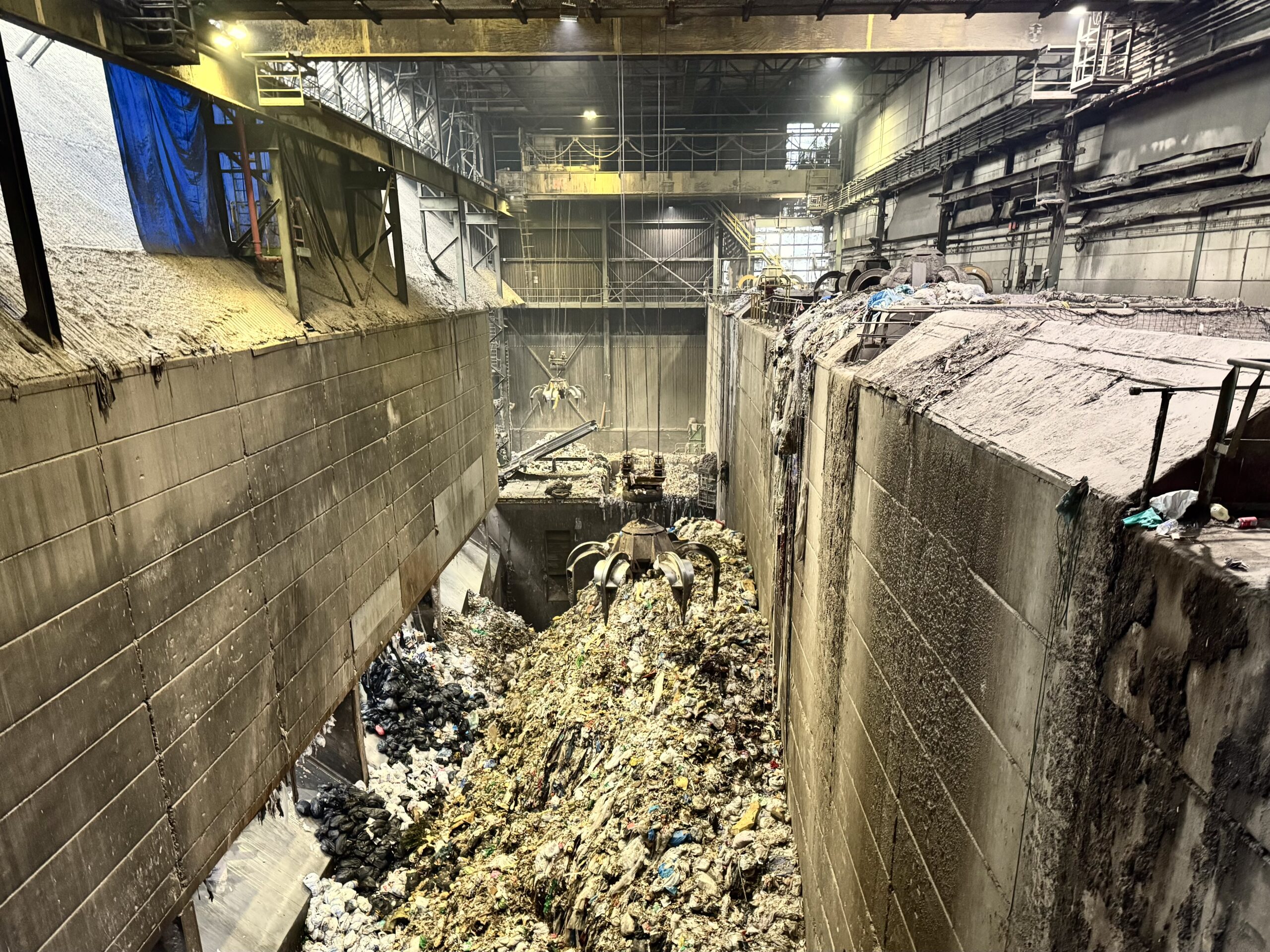
The pit
The lorries then move into a vast, high-ceilinged room, completely open to the elements, before each in turn disgorges their loads. Hellemans warns us to prepare for a pong but it’s nowhere near as rank as you’d think. That said, our visit takes place after most of the lorries have left, save a few stragglers. It’s also a very cold day. A visit at the height of summer – the plant welcomes groups every week – might well prove a different story.
Space of waste
A digger is squishing some of the white bags but most are dropped straight into a cavernous, concrete-walled hole on the other side of the entry hall. This can hold up to 6,000 tonnes of refuse at any given time. The mountain of muck is a spectacular sight. We get to see it twice, from a control room window and then from the top of the building, gazing down into a vast pit of putrefaction.
A crane operator directs what looks like a giant version of an amusement arcade claw machine, spacing the mounds of white bag waste before feeding them into hoppers which lead to three giant furnaces, each with a chamber of 470 cubic metres. Normally three separate processing lines are in continuous operation, but one is closed for maintenance.
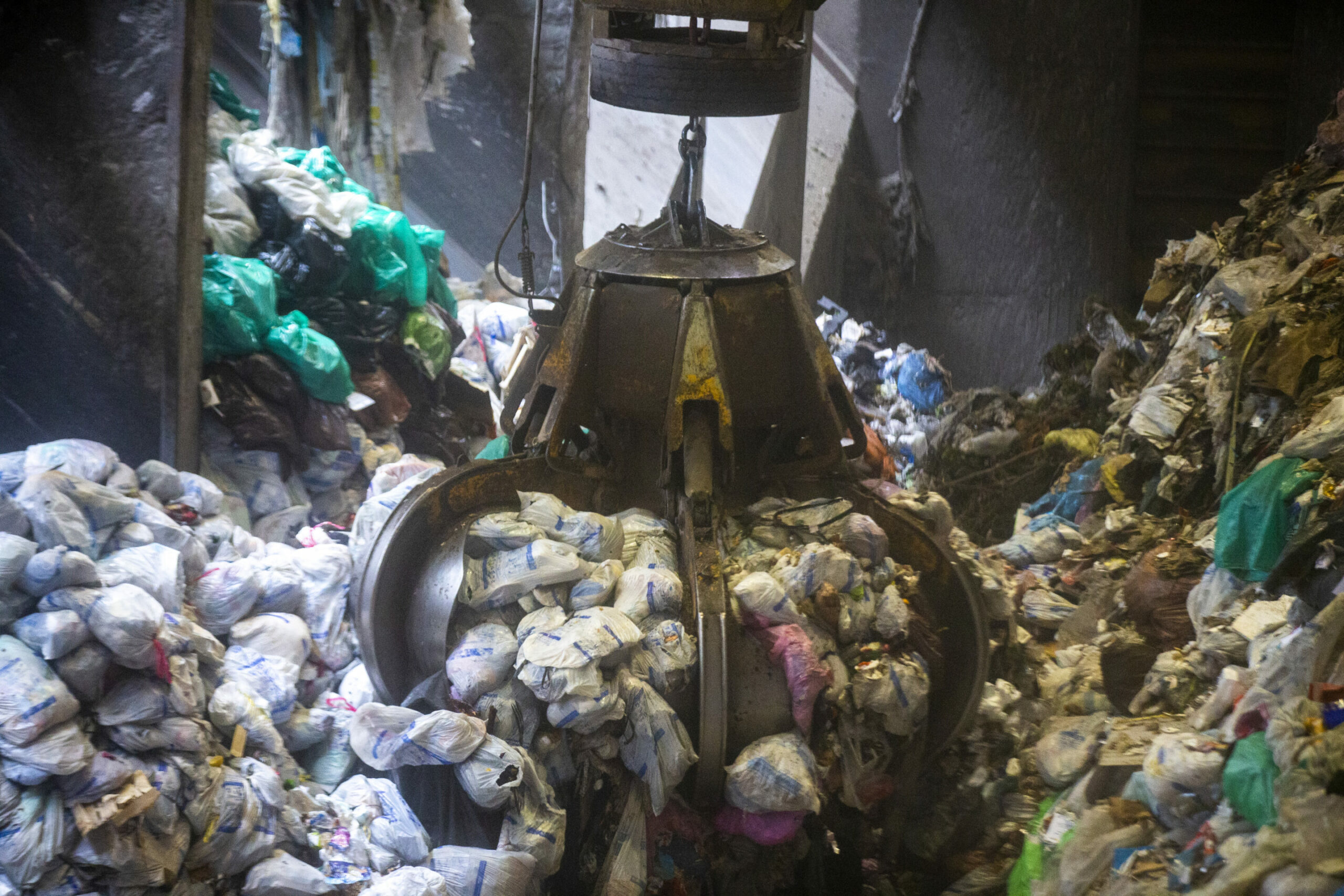
The incinerator of the Brussels Region, Thursday 08 September 2022. Credit: Belga / Nicolas Maeterlinck
The 20-metre long furnaces blast the waste at 900-1000°C degrees centigrade before it enters a series of pipes and boilers, which break it down into reusable byproducts. These include scrap metal which is sold on, ‘bottom ashes’ transported by boat to the Netherlands for road building and foundations, as well as ‘flying ashes’ used for strengthening mine shafts in Germany. “When you mix the flying ashes with water it ends up like concrete,” explains Hellemans.
Solvay soda
The process also incorporates a flue gas ‘DeNOx’ unit which turns nitrous oxides into nitrogen and water, as well as producing heaps of salt for chemical firm Solvay, which uses it in the production of caustic soda, an ingredient in various industrial processes from paper manufacturing to detergents.
“When the plant first opened, everything was burned and went up into the sky,” says Hellemans. “But over the years since it’s been extended and its performance improved to meet new norms and emission rules.”
Theoretically speaking, you can put your head over the top of the chimney and inhale the smoke without any damage to your lungs. “I won’t actually do it myself,” he laughs, “but we’ve come a long way. If we built the chimney today it wouldn’t need to be nearly as big.
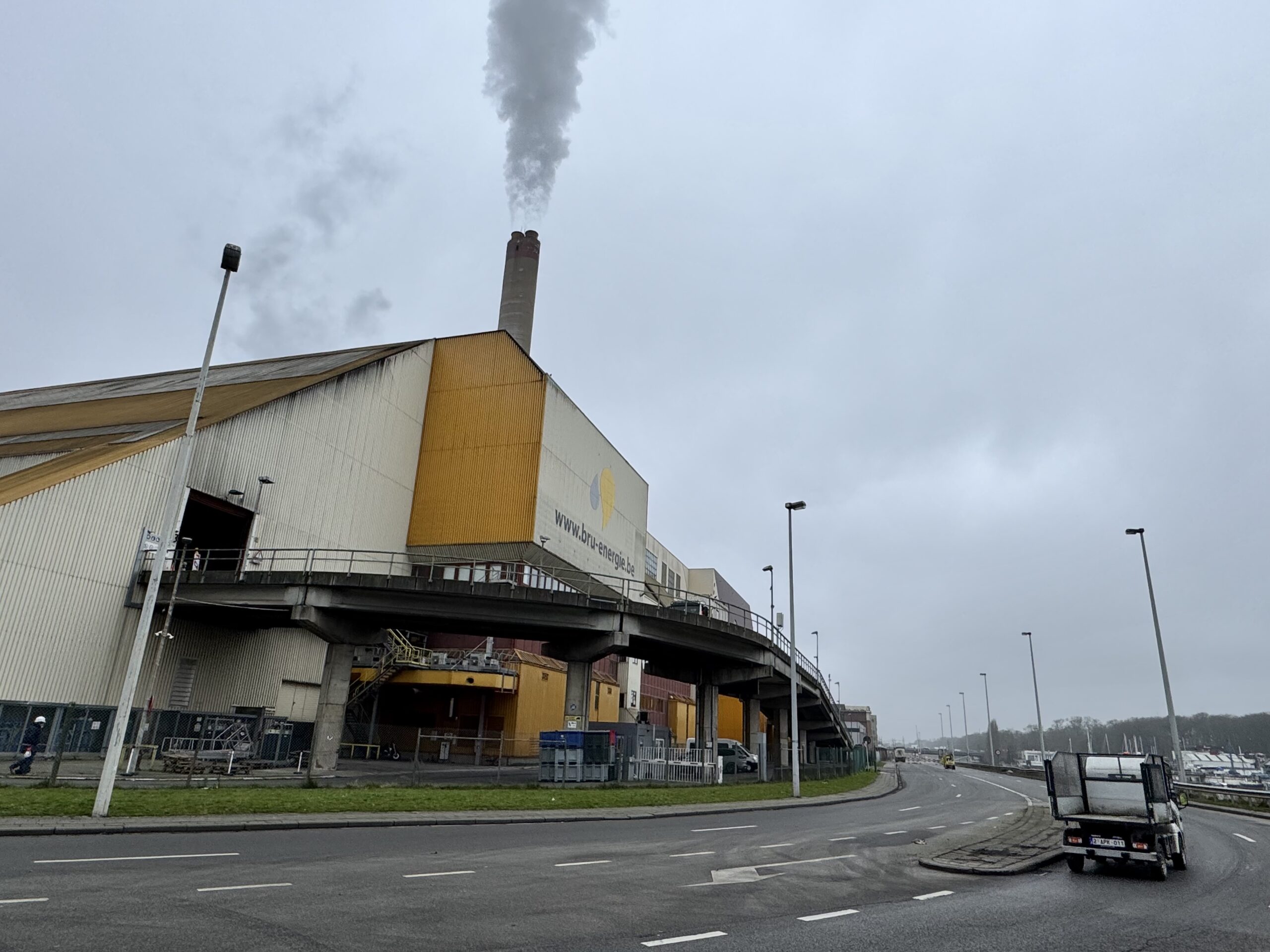
Outside the incinerator
The plant, the largest of 15 waste-to-energy (WtE) incinerators in the country, runs 24/7 with teams of four or five working in three shifts. The three processing lines are completely closed every five years for major maintenance. “There are also mini shutdowns, normally every month or so, if we need to carry out running repairs,” explains Hellemans. “For example, if we have to replace walls and pipes in the ovens. When that happens, we’ll call in mountaineers with ropes to go inside to fix the damage.”
Lansink scale
The plant forms part of the ‘waste hierarchy’ established by pioneering Dutch politician Ad Lansink. The Lansink scale distinguishes the steps for treating waste in priority order: prevention, reuse, recycling, energy recovery, incineration and landfill.
While the Brussels incinerator recovers energy and other useful byproducts, this does not count towards reuse or recycling. “Energy valorisation requires combustion and is less environmentally efficient compared with other recycling process,” explains Hellemans. “That said, any recycling process will involve some remaining materials that can’t be recycled and end up being incinerated. This is why incineration is a key element of the recycling chain.”
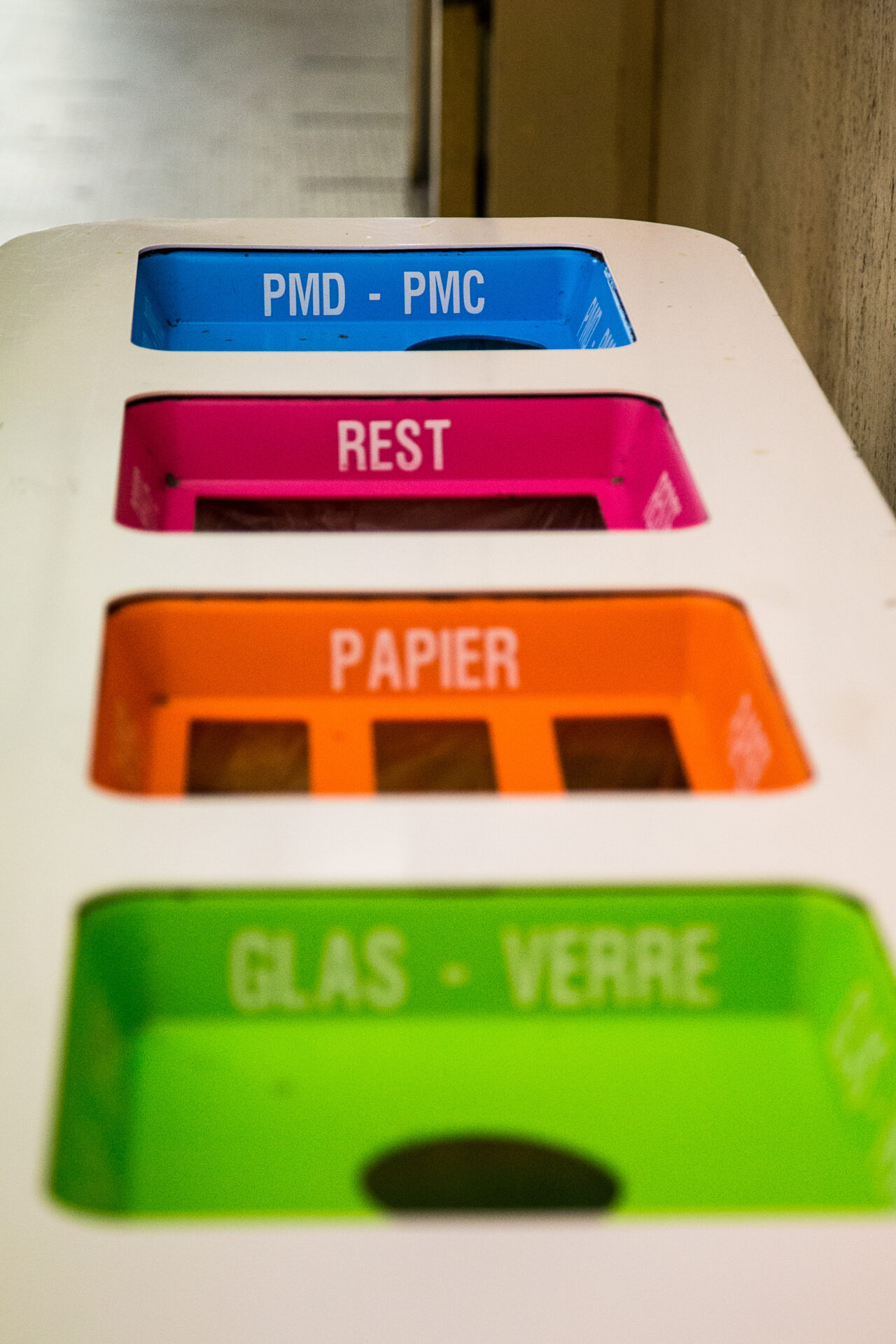
Recycling rubbish bins cans in Brussels. Credit: Belga
A very small quantity of waste processed at the plant, equivalent to 0.1% or less than 500 tonnes, remains highly toxic. Known as ‘cake’, this is encased in cement and, after undergoing leachability tests to ensure it will not contaminate the earth, is buried at a specialised site in a former quarry at Hallembaye near Liège. We are shown a batch of the dark-coloured cake in a large crate. It doesn’t look appetising and I don’t inhale. “The worst we can do is landfill,” Hellmans says – but that accounts for just one thousandth of the region’s total waste.
Related News
- Where and how to dispose of your old clothes?
- Inside Belgium’s hidden art scene
- Amount of bio-waste collected in Brussels has risen by 30% in one year
One of the consequences of increased sorting and recycling is that the plant will inevitably have less waste to process. “We’ve seen a marked decrease in the last two years,” he continues. “The white bags are lighter than before. If we collect 30% less waste, we will have to rethink the way we operate, but that’s in the long term. We’re already working with an ‘ecosystemic’ approach so that the incinerator, the recycling line and composting activity work better together.”
A new biomethanation plant, which will turn food waste into biofuel, is due to open in 2027. “At the moment, a huge amount of trucks are needed to take the orange bags to Ypres to be treated. The idea is to bring them back within the Brussels border and use the waste for heat and electricity generation,” he adds.
“There is no perfect system for collecting and treating waste. We have to constantly adapt. But I’m proud of our environmental performance. It’s one of the best in Belgium.”
Why Brussels has bags rather than bins
Brussels banned single-use plastic bags in stores in 2020 – so why do the authorities insist on using plastic-coloured bags for household waste collection rather than bins or containers?
While most plastic bags are recyclable these days, it’s not a good environmental look.
In less densely populated communes outside Brussels, the use of bins is more prevalent – and costs much less in the long run than buying plastic bags.
“We are gradually changing the model,” Bruxelles-Propreté spoesperson Adel Lassouli says. “The aim is to move towards underground containers or voluntary drop-off points, wherever possible.”
The regional waste authority has already introduced container collection at around 30 recently built sites in Brussels but a complete change of approach is not feasible due to the city’s high density.
“Because of their narrowness and configuration, many streets cannot accommodate this type of container without raising major urban redevelopment issues,” Lassouli explains. “From experience, we know that even temporary drop-off points, used where roadworks prevent lorries collecting door-to-door, are unsatisfactory in terms of sorting results.”
“Unsupervised containers can also mean user responsibility and less virtuous behaviour by residents,” Lassouli says, noting that it is common to see bulky items like old mattresses being dumped in temporary containers. “As soon as there’s a mattress there, it acts like a magnet for all sorts of other unauthorised waste.”

